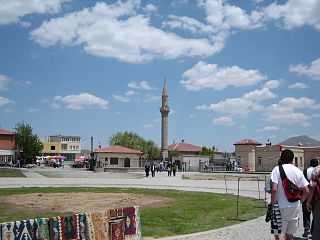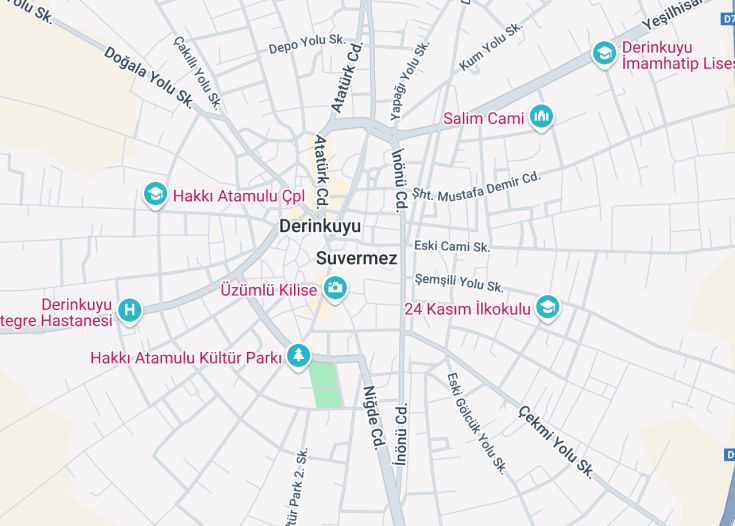Derinkuyu, an ancient underground city in the Nevşehir Province of Turkey, offers a mystifying dive into early Christian history, sprawling deep beneath the Earth’s surface. Originally constructed by the Phrygians in the 8th–7th centuries BCE, this subterranean network served multifarious purposes, from refuge during invasions to a permanent settlement.
Exceptionally preserved, Derinkuyu captivates with intricate passageways, expansive halls, and ingenious ventilation shafts, allowing visitors to step back into a clandestine past, where entire communities thrived unseen, spanning impressive depths and advocating remarkable engineering feats of ancient times.
When visiting Derinkuyu, wear comfortable shoes and carry a flashlight. The uneven floors and limited lighting can make navigation challenging but also add to the adventure of exploring this underground marvel.
Book your visit early in the day to avoid crowds and to fully experience the eerie silence and cool, dim environments of the underground passageways where early Christians once moved stealthily to protect their faith.
Top things to do & see in Derinkuyu
Select the following sights and activities to discover best tickets and tours available in Derinkuyu.
Derinkuyu: A Subterranean Marvel
| Country | Turkey |
| Time in Derinkuyu | GMT+3 |
| Language spoken | Turkish |
| Population | 2,165 (2023 Estimate) |
| Currency | Turkish Lira (₺, TRY) |
| Airports |
|
Derinkuyu, a town in Cappadocia, central Turkey, is famous for the Derinkuyu Underground City, which is the largest excavated underground city in Turkey. Hidden for centuries, this underground city was revealed in 1963 and initially thought to have been created during the Byzantine period, primarily as a protection from Muslim Arabs during the Arab–Byzantine wars (780–1180 AD). The city extends to a depth of approximately 85 meters and it was capable of sheltering as many as 20,000 people together with their livestock and food stores.
The underground city includes discrete levels with various rooms and tunnels, including residences, stables, churches, storage rooms, and wineries. Connected by miles of tunnels, it features a massive circular door stone, which could be rolled to block access during attacks. Intricate ventilation shafts provide air and testaments to the architects’ ingenuity. The city’s strategic depth ensures a steady temperature of about 12-13 degrees Celsius year-round, providing an ideal environment for storing perishables and human habitation.
Despite the city being thousands of years old, it showcases advanced building techniques of its time. The ability to house thousands, including spaces for domestic animals and complex communal living facilities, speaks volumes of their sophisticated understanding of architectural and urban planning. Moreover, the religious sanctuaries and educational rooms depict a well-rounded social structure and culture. Tours through the underground structures provide insights into the challenging yet organized life during historical times.
Today, Derinkuyu not only serves as a significant archaeological site but also attracts tourists from across the globe. Its historical depth and extraordinary construction offer a living classroom for archaeologists and historians, giving invaluable insight into ancient defensive strategies and urban planning while mesmerizing visitors with its ancient mystery and marvel.
Where is Derinkuyu?
Located in the Nevşehir Province of Central Anatolia in Turkey, Derinkuyu is part of the historical region known as Cappadocia.
Distances:
| Route | Distance by car | Time by car |
|---|---|---|
| Ankara to Derinkuyu | 188 miles (302 km) | 3 hours |
| Istanbul to Derinkuyu | 465 miles (748 km) | 8 hours |
What is Derinkuyu famous for?
Derinkuyu is renowned for its ancient underground city, believed to have been built as a massive refuge during the Byzantine era. Its extensive network of caves, rooms, and tunnels extend up to 60 meters underground, showcasing advanced ancient engineering.
History
Prehistoric Era to Byzantine Period
Derinkuyu’s fascinating journey begins in the prehistoric era when the first inhabitants carved out subterranean shelters in the soft volcanic rock known as tuff. Initially, these underground chambers were likely used as temporary refuges from natural disasters and hostile invasions. As time progressed, these spaces evolved into more complex, multi-level underground cities during the Byzantine era. The height of development in Derinkuyu was realized between the 5th and 10th centuries AD when the city was expanded to accommodate up to 20,000 people along with livestock, providing a safe haven from Arab Byzantine wars.
11th Century to Ottoman Empire
Following the decline of Byzantine rule, the region saw a period of fluctuation in control but continued to serve as a protective retreat. During the Seljuk and later the Ottoman era, the underground city of Derinkuyu was not primarily used as a dwelling; instead, it was occasionally used for military purposes and as a place of hiding during the frequent conflicts that swept the region. The city’s sophisticated ventilation shafts, wells, and tunnels highlight the ingenuity of its creators.
Rediscovery in the 20th Century
The modern story of Derinkuyu began in 1963 when a local inhabitant discovered a hidden room behind a wall in his home, leading to the rediscovery of the expansive subterranean network. Subsequent excavations have laid bare multiple levels of the underground city, revealing living quarters, stables, churches, and schools, intricately connected through miles of tunnels. Today, Derinkuyu is not only a key archaeological site but also a poignant reminder of human resilience and ingenuity in the face of adversity.
Visit Derinkuyu
What to see and do in Derinkuyu
Exploring Derinkuyu offers a unique glimpse into an ancient underground world. Visitors can wander through the narrow passages and discover rooms dug out a millennium ago, including communal areas, wineries, and chapels. The third level houses one of the most impressive finds: a cruciform church carved directly out of the rock.
Visitors can also explore the ventilation shafts and wells that were critical for the survival of thousands of inhabitants during prolonged periods underground. For a deeper understanding, guided tours are available, providing insights into the historical context and engineering marvels of Derinkuyu.
Festivities in Derinkuyu
Derinkuyu also hosts several cultural events throughout the year that showcase local traditions and crafts. These events typically occur during spring and autumn, giving visitors a chance to engage with the community and experience local hospitality alongside the exploration of historical wonders.
Best time to visit Derinkuyu
The best time to visit Derinkuyu is during the spring (April to June) or autumn (September to November). During these months, the weather is mild, making it comfortable to explore the depths of the underground city.
Additionally, the reduced number of tourists in these off-peak seasons offers a more tranquil visit.
Is Derinkuyu worth visiting?
Derinkuyu is undoubtedly worth visiting for anyone fascinated by history, architecture, or engineering. The site offers a rare look at ancient ingenuity and provides a tangible connection to past civilizations who skillfully crafted these extensive subterranean sanctuaries. Exploring the well-preserved tunnels and rooms of Derinkuyu not only educates visitors about historical survival strategies but also offers a unique perspective on human resilience and adaptability.









